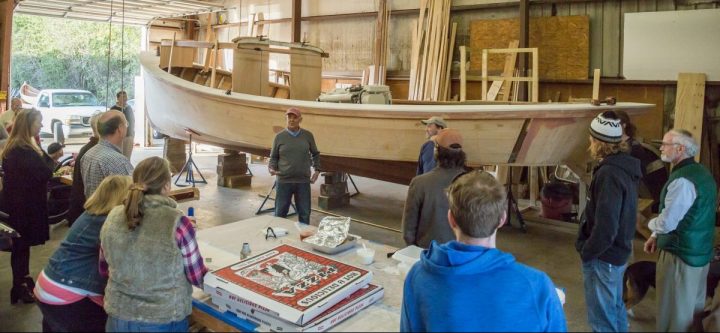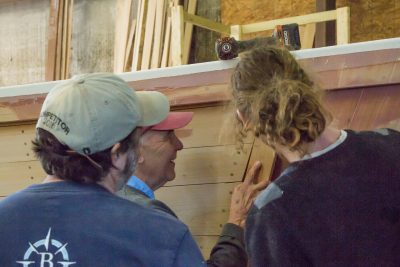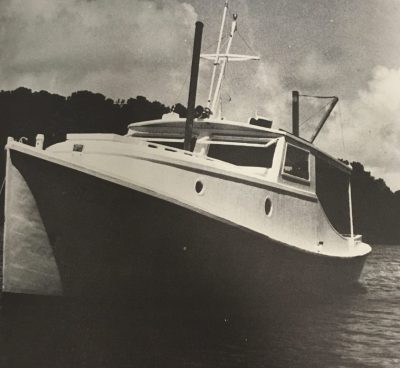
WILMINGTON — A child gently drifts on a wooden swing hung by dock rope from the rafters of an unassuming workshop near Wilmington International Airport. Behind the swing – and a resting border collie that migrated from a neighboring shop – history is in the making, or rather, the restoring.
As the final wooden plank of the hull of Sylvia II, said to be the oldest charter vessel in existence in North Carolina, is put in place, owner Bob Graham raises a glass of whiskey in celebration of the milestone. The builders had signed their names and etched the date of this “whiskey plank” party – perhaps the third such celebration for this vessel – upon the final plank before settling it into the hull. This chock of Sylvia II’s history will remain hidden, like so many yarns in this vessel’s storied history, until time or circumstance commands it to the surface.
Supporter Spotlight

Stories of the past seem to seep out of Sylvia II’s woodwork, inciting chatter about Down East Carteret County culture, history, geography and, of course, a few fish tales. As guests spanning generations sip whiskey or play on the swing, depending on their age, it’s not lost on some that this party, which took place on Feb., 16, came just two days, and 83 years, after Sylvia II’s keel was laid in Morehead City. Fisherman and boatbuilder James Riley Willis did that on Valentine’s Day 1933.
Willis and his partner Micijah Adams were regarded as master builders of Core Sound boats, which were designed for the shallow but typically choppy seas off the shores of Carteret County, and are distinguished by their round sterns that provide fishermen a working platform from which they pulled aboard their nets.
Willis named the boat after his granddaughter, Sylvia Willis Dalton. The first Sylvia is presumed to have met the fate of many Core Sound boats of that era: abandoned or destroyed after its working days came to an end. Sylvia II still bears a piece of its predecessor, the original cabin nameplate, which reads simply “Sylvia.”
Willis worked Sylvia II as a commercial fishing boat, supplying markets and others in the Beaufort area, including a Morehead City landmark, the Sanitary Fish Market and Restaurant, which opened its doors in 1938 with 12 stools and a kerosene burner. The famous attraction now offers seating for up to 500 diners.
The Navy commandeered the Sylvia II during World War II for patrols and supplies transport along the Outer Banks. After the war, Sylvia II was returned to Willis, who docked the boat at the Sanitary, beginning the boat’s charter fishing days. The mooring was also the site of the vessel’s near demise.
Supporter Spotlight
On Feb. 2, 1976, weathermen forecasted light and variable winds and a 10 percent chance of rain, but local watermen became increasingly concerned as they watched their barometers plunge steadily downward at dusk. Capt. Theodore Lewis, then skipper of Sylvia II, battened down the hatches and hoped for the best, but that night, the sea grew nasty and, during what later came to be known as the “Groundhog Day Gale,” the Sylvia II was sunk at the Sanitary dock.

‘She’s Your Problem’
In his book, “When the Water Smokes: Tides and Seasons on a Wooden Boat,” writer Bob Simpson recounts the exchange that would make or break the fate of Sylvia II as he and Capt. Lewis surveyed her mud-covered remains the morning after the storm:
“I’ve always liked her … seems a shame to let her go.”
“Two hundred bucks and she’s your problem.”
“Tell you what, Theodore, it’s a deal, but I’ll give you till tomorrow to reconsider.”
Coastal Review Online reached Simpson, now 91, at his home on Pelletier Creek and he was eager to “weave a tale or two,” as he put it, about Sylvia II.
By the time of the exchange on the dock that day in 1976, Bob’s wife Mary had already become accustomed to life at sea, thanks to a similarly hasty decision made in that same harbor 18 years prior. The couple and Simpson’s younger brother, who was put in his charge after their mother died in an airplane accident, had just arrived in Morehead City from North Dakota. The Simpsons had been introduced to the area during Bob’s time serving active duty in the Marine Corps.
Simpson was having a cup of coffee at Captain Bill’s Restaurant in Morehead City and talking over housing options when a local asked if he ever thought about living aboard a boat.
“It’s the best living in the world,” the man declared, per Simpson’s retelling of the story. “Let me show you a boat.”
They walked around the waterfront and Simpson stepped aboard a 45-foot cruiser, the Silver Spray. Simpson turned to his wife and said, “What do you think?” Her reply, “I’m game if you are.”
“We ended up buying a boat,” Simpson said. “Well the bank bought the boat and we paid them for it – and we lived on that boat for 18 years.”
By the time the Sylvia II was sunk, the Simpsons had parted ways with the aging Silver Spray, but over the years, the couple had acquired a home – on dry ground – and were by no measure looking for another investment. They talked it over that night, in the way Simpson explained in his book was their customary fashion when big decisions were at hand.
“Suits me if it suits you.”
The next morning, the Simpsons paid Lewis $300, beginning the Simpsons’ foray into saving the Sylvia II. After hoisting the boat from its murky resting place, Mary Simpson assigned herself to mud removal. Mary was well suited for the job, as she could fit her entire body through a hole in the bow.
Once fully restored, the Simpsons embarked upon decades of adventures aboard the Sylvia II, traveling up and down the Atlantic Intracoastal Waterway. Bob, a seasoned nature writer, reported many of these experiences for the News & Observer of Raleigh before chronicling his accounts in his book.
Mary died in 2005, and as Bob and Sylvia II aged, their days on the water faded. But, Simpson made sure to get the Sylvia II back to the Sanitary dock every Valentine’s Day for a birthday celebration.
Later, Simpson set about securing a future for his beloved boat, which included a failed attempt at landing the Sylvia II at the North Carolina Maritime Museum in Beaufort and a discussion among wooden boat enthusiasts about creating a nonprofit group to manage a restoration. As time took its toll on the boat, Simpson decided to place an ad in Wooden Boat Magazine.
A Missing Zero?
Meanwhile, Bald Head Island transplant Bob Graham, who had for years been looking for a wooden boat to restore, came across a photography exhibit at the North Carolina Museum of History in Raleigh entitled “Workboats of the Core Sound,” by Lawrence Earley. Graham was fascinated with the stories of these disappearing boats and the vanishing way of life associated with them. But he had his eye on buying and restoring a Concordia yawl, a wooden sailboat designed in 1938 for cruising and racing. He had tucked away the idea of owning a Core Sounder until, he said, “Two things happened, I got old and the sailboats got more expensive.”
Then one day, Graham was thumbing through Wooden Boat Magazine, and spotted the Syvia II.
“There she was in the back of the book,” Graham said.

Just as Simpson had nearly 40 years prior, Graham bought the Sylvia II for a bargain. Graham initially thought there was a zero missing from the asking price. Unable to recall the exact price, Graham said he recalled paying about $2,800.
Asked whether the restoration had been similarly affordable, Graham smiled. “No comment.”
In 2016, after initial work by Wilmington boatbuilder Richard Reid, Graham asked Mark Bayne, a lifetime wooden boatbuilder and head of Cape Fear Community College’s wooden boatbuilding program, to assemble a team to continue the restoration.
Under Bayne’s guidance, Chris Sargent, this reporter’s husband and an alumni of the college’s boatbuilding program, took the helm as the lead boatwright. Sargent, working alongside fellow alum Adrian Dobson and owner Graham now hope to have the Sylvia II seaworthy in time for the North Carolina Maritime Museum’s annual Beaufort Wooden Boat show in May. The restoration team hopes Simpson will be there to witness the Sylvia II’s return to Beaufort waters.
But the work is slow-going, said Sargent. “It was originally built by eye, so that’s the way we have to do it; we’re attempting to put everything back the way it was without a plan.”
Beyond the challenges of the build, Sargent said, countless hours are spent locating materials. “We gotta figure out who still makes certain things, and who’s willing to part with them.”
For instance, all the fasteners are silicon bronze, he said, “and of course, we’re working on a budget.”
Simpson wrote of similar challenges in tracking down materials for the original build. In his travels, Simpson came across Wallace Guthrie, who had reminisced about going over to Bogue Banks to find timber for the stem,
“Looked all over the woods ’fore we found one that’d suit William Riley (Willis),” Simpson quotes Guthrie as saying at the time.
Graham and his wife Tisha seem to have much in common with Bob and Mary Simpson, and the Grahams plan to be the next to test the Sylvia II’s endurance. Tisha says she’ll go anywhere.
“I’d like to see how long my bravery and seamanship can take her,” Bob said.
Graham has a manual for the Sylvia II in Simpson’s, “When the Water Smokes …” : “She’s tight and dry, and her handling is a dream: set the rudder amidships after aiming her, and, if she drifts slightly, just step to the side and she’ll change course.” But, he reminds, “She’s Carolina born and bred and that is where she belongs.”








